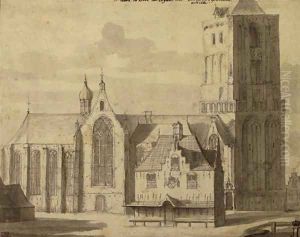Johannes Abrahamsz. Beerstraaten Paintings
Johannes Abrahamsz. Beerstraaten was a Dutch painter born in 1622, in the midst of the Dutch Golden Age, a period renowned for its remarkable achievements in the arts, sciences, and commerce. His life and career were cradled in Amsterdam, a bustling hub for artists, traders, and intellectuals. Despite the abundance of historical records on artists from this era, details about Beerstraaten's personal life remain somewhat obscure, mirroring the fate of many artists of his time. However, his surviving works offer a glimpse into his artistic pursuits and the broader cultural context of 17th-century Netherlands.
Beerstraaten is best known for his masterful landscapes and cityscapes, imbued with a meticulous attention to atmospheric effects and details. His oeuvre includes a variety of scenes, from serene depictions of the Dutch countryside to vivid portrayals of urban life in Amsterdam. Among his most celebrated works are his winter landscapes, which capture the beauty and brutality of the season with exceptional realism and emotional depth. These paintings not only showcase his skill in rendering the play of light on snow but also reflect the Dutch penchant for scenes of everyday life.
Another significant aspect of Beerstraaten's work is his contribution to the genre of maritime painting, a genre that held particular significance in the Netherlands, a nation with burgeoning naval power and overseas trade. His seascapes display a keen understanding of the sea's changing moods, from the tranquility of calm waters to the ferocity of storms, highlighting the Dutch struggle and harmony with the sea.
Despite his evident skill and the quality of his work, Johannes Abrahamsz. Beerstraaten did not achieve the same level of fame as some of his contemporaries, such as Rembrandt or Vermeer. This relative obscurity may be attributed to the sheer number of talented artists working during the Dutch Golden Age, which made the art scene incredibly competitive. Nevertheless, his paintings are valued today for their historical significance and their contribution to the rich tapestry of Dutch Golden Age art.
Johannes Abrahamsz. Beerstraaten passed away in 1666, leaving behind a body of work that, while not as widely recognized as that of some of his peers, offers valuable insights into the cultural and natural landscapes of 17th-century Netherlands. His paintings continue to be studied and admired for their beauty, technical skill, and as a window into the Dutch Golden Age. Through his art, Beerstraaten remains a part of the enduring legacy of one of the most prosperous periods in Dutch history.
